Are you a Sydney SME owner or executive bogged down by manual processes that drain your time, inflate your costs, and hinder your organisation's growth? Picture a future where repetitive tasks are handled seamlessly, your team focuses on strategic initiatives, and your bottom line reflects true efficiency. At C9, Australia's leading custom software, apps, integration, and database developer, we've empowered countless businesses just like yours to escape the frustrations of off-the-shelf solutions and embrace bespoke automation tailored to your unique needs. This in-depth guide serves as your comprehensive roadmap to implementing business process automation (BPA)—packed with facts, statistics, real-world examples, and actionable knowledge to help you achieve operational excellence without the pitfalls.
In Sydney's dynamic business environment, where SMEs make up over 97% of New South Wales enterprises according to the Australian Bureau of Statistics, the pressure to optimise is immense. Yet, many are still reliant on outdated manual workflows, leading to inefficiencies that cost up to 30% in lost productivity. With the Australian BPA market projected to grow at a compound annual growth rate (CAGR) of 10.2% from 2025 to 2030, reaching over AUD 4.5 billion, now is the time for Sydney SMEs to act. At C9, we don't offer generic fixes; we deliver innovative, trustworthy, and collaborative solutions that align with your goals of increasing efficiency, reducing costs, driving profits, and gaining a competitive advantage.
The Automation Imperative for Sydney SMEs
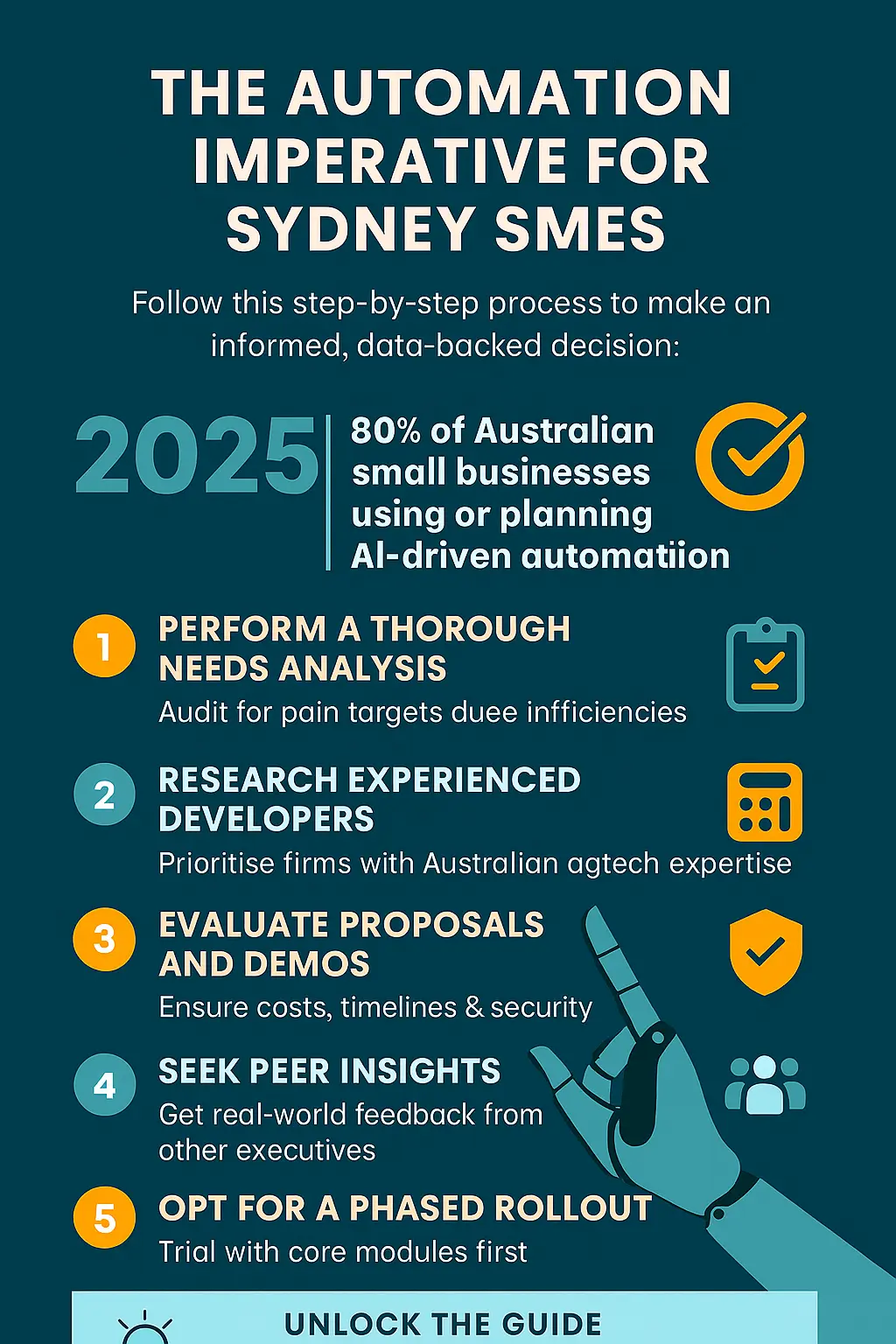
Sydney's SME landscape is thriving yet challenging. From bustling tech hubs in Barangaroo to family-run operations in the suburbs, business owners face escalating operational demands amid economic pressures like rising wages and supply chain disruptions. Manual processes—such as data entry, invoicing, and reporting—not only consume valuable hours but also introduce human errors that can erode customer trust and profitability.
Consider this: In 2025, 80% of Australian small businesses are either using or planning to adopt AI-driven automation, shifting it from a 'nice-to-have' to a 'must-have'. Moreover, 82% of SMEs have embraced AI, reporting enhanced operational efficiency and business growth. For Sydney executives, ignoring BPA means risking stagnation while competitors leverage tools like robotic process automation (RPA) and AI workflows to streamline operations.
At C9, we understand your pains: missing growth targets due to inefficiencies, high costs from manual labour, poor customer experiences from delays, outdated legacy systems, and competitors' tech advancements. This guide dives deep into BPA implementation, drawing on industry knowledge and our expertise in custom software to provide a trustworthy path forward. We'll cover assessments, tools, steps, challenges, discovery calls, pricing pitfalls, case studies, and ROI measurement—all tailored for driven, analytical leaders like you.
Understanding Business Process Automation – What It Is and Why Sydney SMEs Need It Now
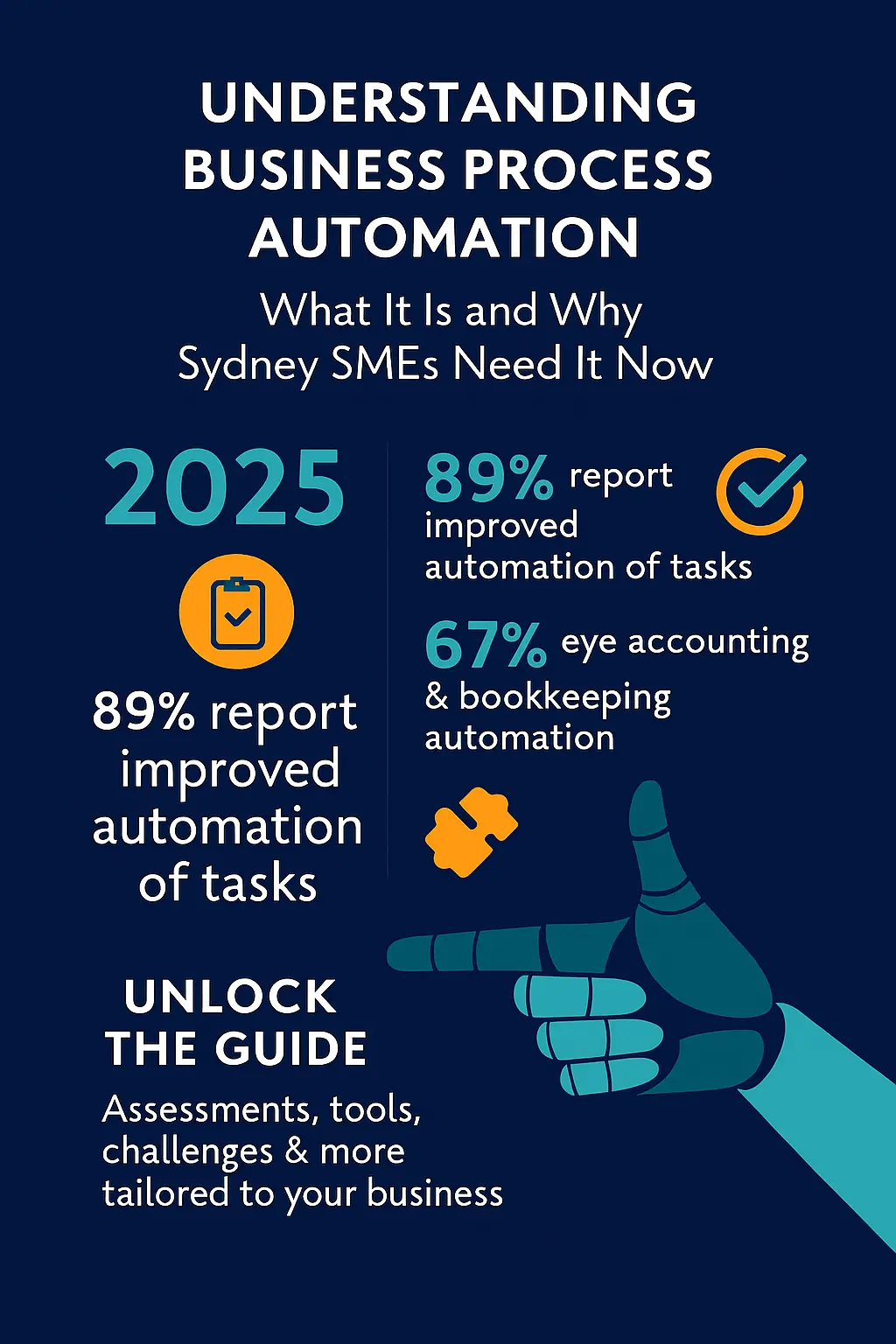
As a Sydney executive, you're likely grappling with fragmented workflows where employees spend hours on repetitive tasks like data reconciliation or compliance reporting. These issues stem from outdated systems that create data silos, leading to high operational costs—often 20-30% higher than automated peers—and poor experiences that frustrate customers and staff alike.
Without intervention, these pains escalate: Missed deadlines compound into lost revenue opportunities, employee burnout fuels turnover (costing up to 150% of salary per replacement), and competitors with sleek tech pull ahead, capturing market share in Sydney's competitive sectors like retail, finance, and logistics. In a city where commercial rents and wages are among Australia's highest, clinging to manual processes could jeopardise your organisation's survival.
BPA involves using software to automate routine business processes, integrating tools like RPA for rule-based tasks (e.g., invoice processing) and AI for intelligent decision-making (e.g., predictive analytics). For Sydney SMEs, this translates to tangible benefits: 89% of small businesses leveraging AI report improvements in automating repetitive tasks, while 67% view accounting and bookkeeping automation as their top investment in 2025.
Why now? Australia's digital transformation trends show SMEs adopting BPA for improved agility, with sectors like manufacturing and tech leading at over 35% implementation rates. At C9, our collaborative approach ensures custom integrations that eliminate silos, enhance security under Australian data laws, and align with your goals—turning pains into profits.
Assessing Your SME's Readiness for BPA
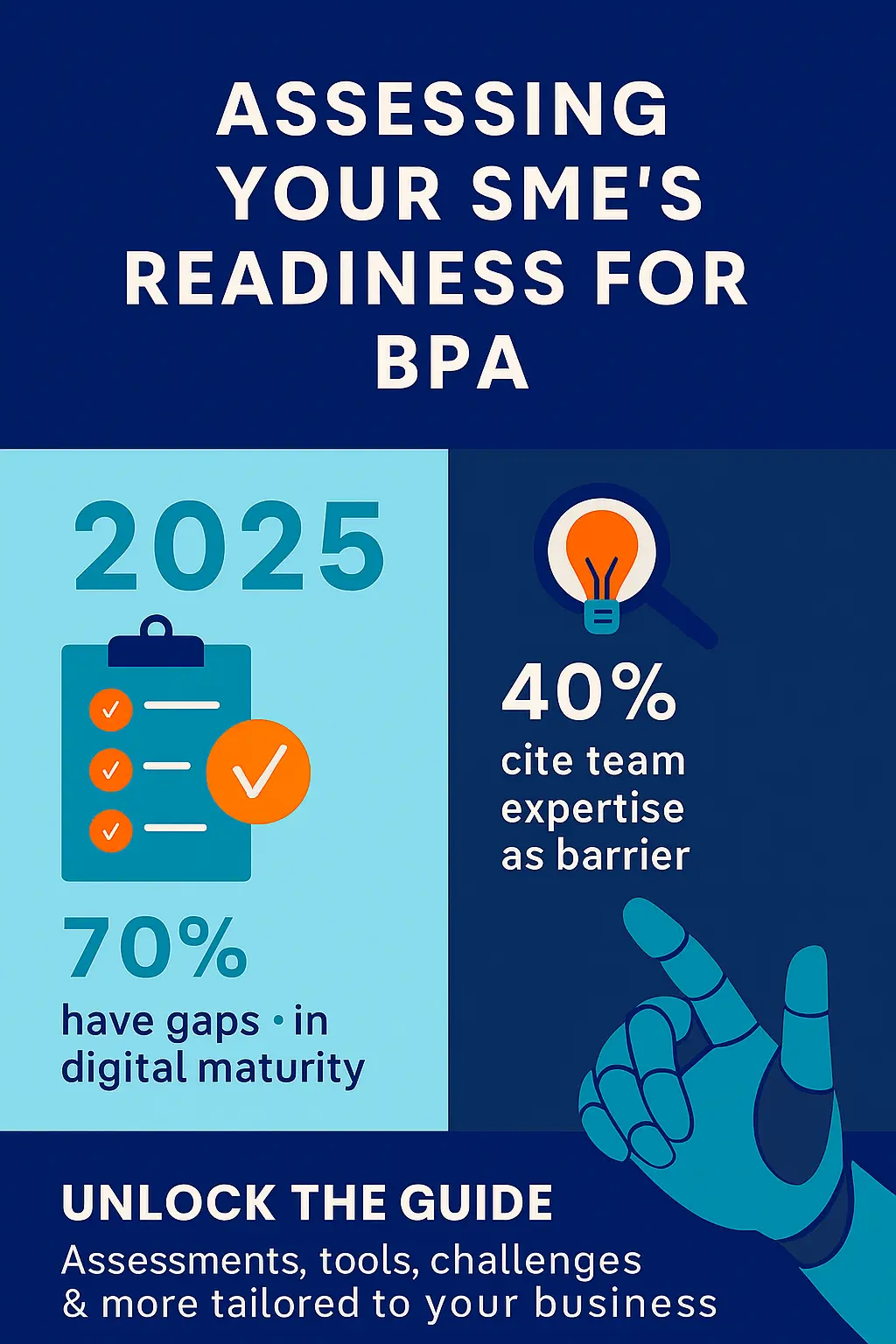
Before implementation, conduct a thorough audit. Start by mapping workflows: Document each step in processes like order fulfilment or HR onboarding, quantifying time and costs. Use tools like process mining software to identify bottlenecks—e.g., manual approvals taking days instead of minutes.
Research from ThoughtLab on Australian SMEs highlights that digital maturity assessments reveal gaps in 70% of organisations, often in data integration. Evaluate your tech stack: Do you have compatible systems like Xero or MYOB? Assess team skills—lack of expertise is a common barrier, affecting 40% of SMEs.
This step is crucial for analytical executives; it provides data-driven insights to prioritise high-impact areas, ensuring your BPA investment yields quick wins.
Choosing the Right BPA Tools and Technologies for Sydney Businesses
Low-code platforms like Microsoft Power Automate for quick setups, RPA tools like UiPath for rule-based automation, and AI-driven solutions for advanced analytics. For Sydney SMEs, prioritise scalable, cloud-based tools that comply with Australian privacy regulations.
Generic tools often fail integration, aggravating costs and downtime. C9's custom apps solve this by building bespoke solutions—e.g., integrating databases with legacy systems for seamless data flow. Trends show 20% growth in AI spending to AUD 3.5 billion in 2024, extending into 2025, making hybrid AI-RPA ideal for efficiency gains.
Step-by-Step Implementation Roadmap
Implementing BPA requires a structured approach:
1. Planning Phase: Define objectives, e.g., reduce processing time by 40%. Involve stakeholders for buy-in.
2. Design and Development: Create prototypes, focusing on user-friendly interfaces to minimise resistance.
3. Testing and Integration: Simulate real scenarios; integrate with existing tools to avoid disruptions.
4. Deployment and Training: Roll out in phases; provide comprehensive training.
5. Monitoring and Optimisation: Use KPIs like error rates; iterate based on data.
Australian guides recommend starting with pilot projects for 20-30% faster adoption. Break projects into stages: Phase 1 automates a core process (e.g., invoicing, saving AUD 10,000/month), reinvesting savings into Phase 2 (e.g., AI forecasting). This delivers early ROI, feeding efficiencies back for sustained growth.
Overcoming Common Challenges in BPA Adoption for Sydney SMEs
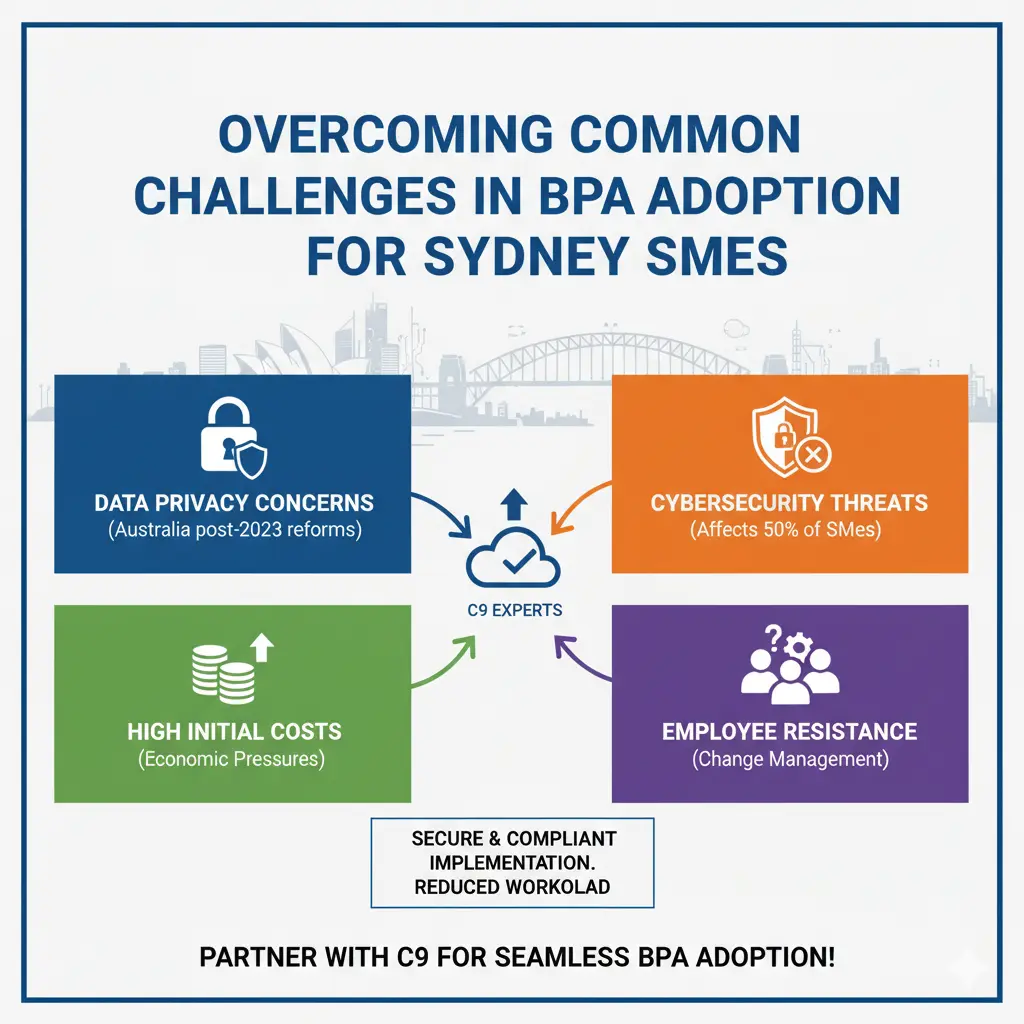
Challenges include data privacy concerns (critical in Australia post-2023 reforms), cybersecurity threats (affecting 50% of SMEs), high initial costs, and employee resistance. Economic pressures like inflation add urgency.
Partner with experts like C9 for secure, compliant implementations. Address resistance through change management, showing benefits like reduced workload.
The Crucial Role of Discovery Calls in BPA Success
Discovery calls are essential —they uncover your specific pains and tailor solutions. Skipping them is the worst idea, as it results in misaligned projects that waste resources and delay benefits.
They reveal triggers like outdated systems, enabling precise strategies that boost efficiency by 25-50%.
Rushing to implementation without insight leads to over 40% ROI underestimation, with projects failing due to overlooked barriers.
Breakdown of How Discovery Calls Work:
- Step 1: Scheduling (5-10 mins): Align on goals.
- Step 2: Deep Dive (30-60 mins): Explore pains, triggers, and barriers analytically.
- Step 3: Insights Sharing: Offer staged recommendations for early ROI.
- Step 4: Next Steps: Custom plan outline.
Clients see 20-30% faster rollouts; it's an investment in trust and precision.
Measuring ROI and Long-Term Benefits
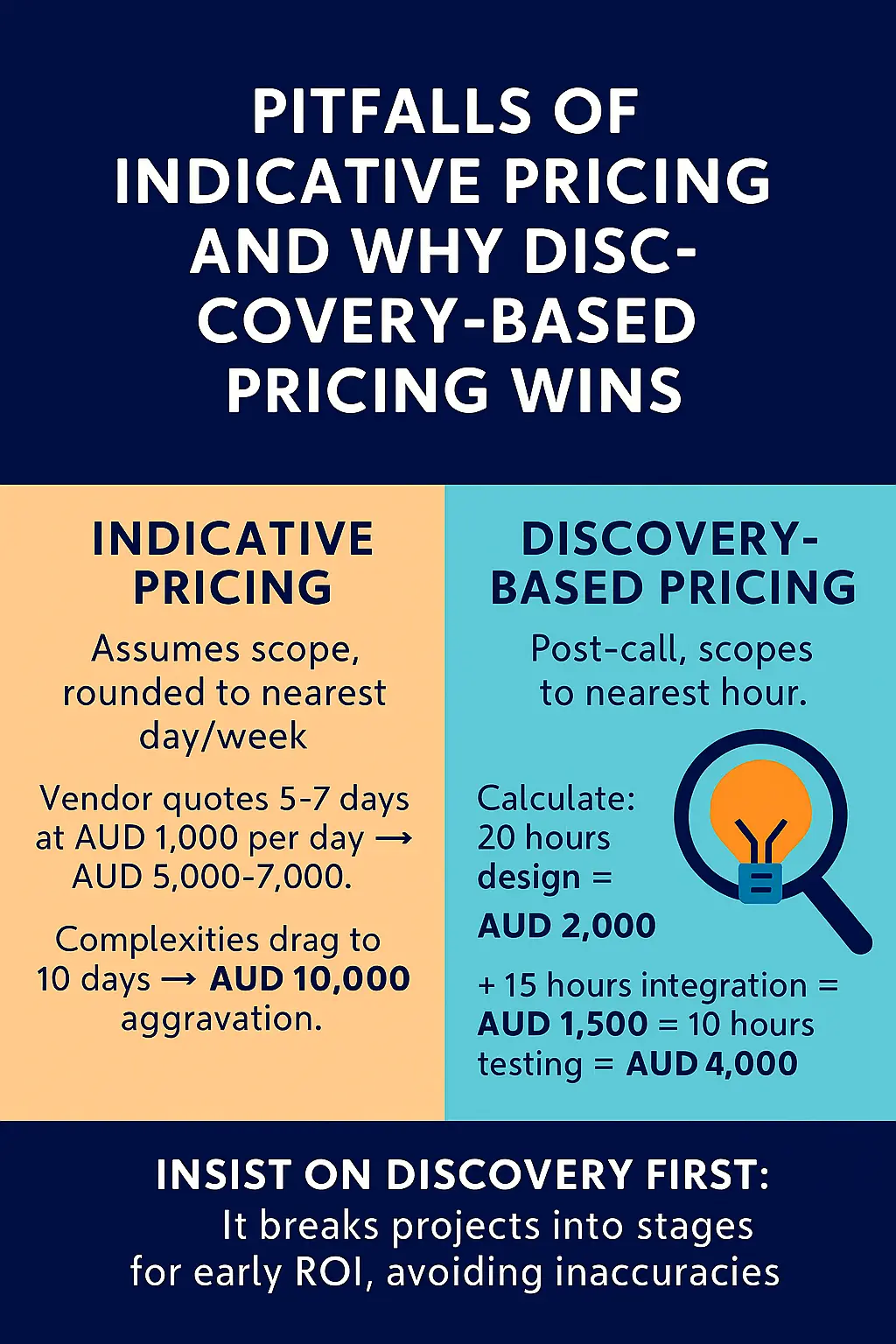
48% of businesses report positive ROI in the first year, with averages of 300% over 18 months. Staged projects ensure quick wins, like 320% ROI on email automation.
Pitfalls of Indicative Pricing and Why Discovery-Based Pricing Wins
Indicative pricing proposals are pitfalls not worth the paper they're written on—they're vague guesses leading to overruns and distrust.
How Indicative Pricing Is Done vs. Discovery-Based Pricing:
- Indicative Pricing: Assumes scope, rounded to nearest day/week. Example: Vendor estimates 5-7 days for automation at AUD 1,000/day, quoting AUD 5,000-7,000. Complexities (e.g., integrations) push it to 10 days (AUD 10,000), causing aggravation.
- Discovery-Based Pricing: Post-call, scopes to nearest hour. Example: After discovery, calculate: 20 hours design (AUD 100/hr = AUD 2,000) + 15 hours integration (AUD 1,500) + 10 hours testing (AUD 1,000) = precise AUD 4,500.
Insist on discovery first: It breaks projects into stages for early ROI (e.g., Phase 1 saves AUD 5,000/month, funding Phase 2), avoiding inaccuracies.
Unlock Your Sydney SME's Potential with C9
BPA is your key to efficiency and growth. With C9's expertise, transform pains into advantages.
Ready to optimise? Schedule a free discovery call with C9. Let's collaborate on custom solutions that drive your success. Contact us today!